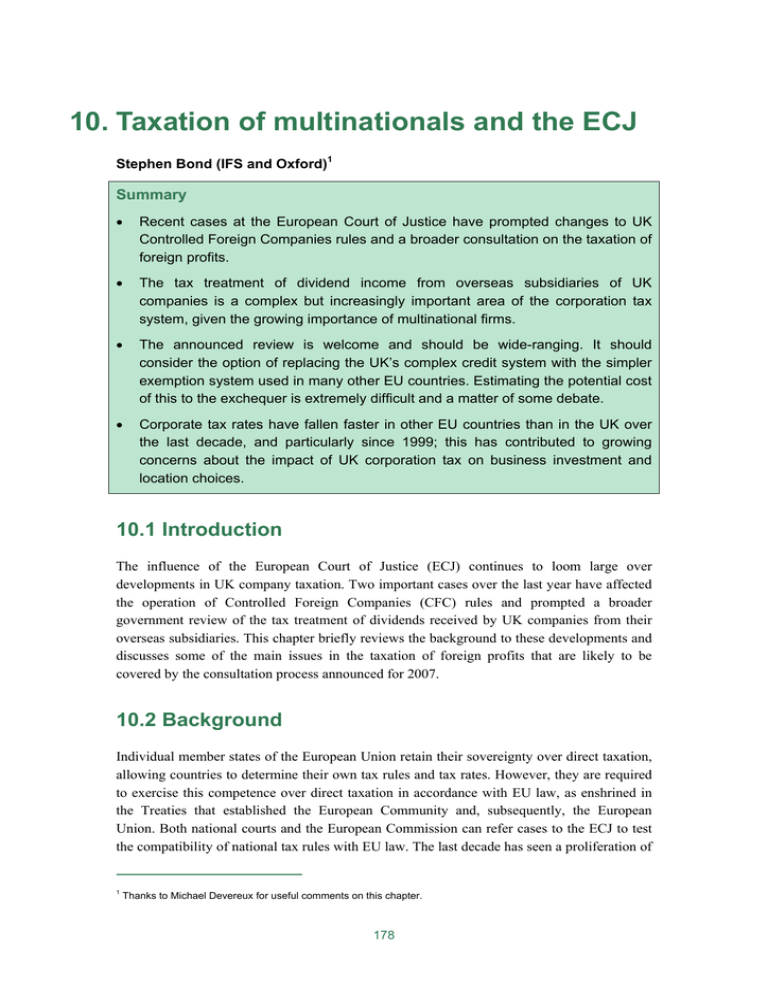10. Taxation of multinationals and the ECJ Summary
advertisement

10. Taxation of multinationals and the ECJ Stephen Bond (IFS and Oxford)1 Summary • Recent cases at the European Court of Justice have prompted changes to UK Controlled Foreign Companies rules and a broader consultation on the taxation of foreign profits. • The tax treatment of dividend income from overseas subsidiaries of UK companies is a complex but increasingly important area of the corporation tax system, given the growing importance of multinational firms. • The announced review is welcome and should be wide-ranging. It should consider the option of replacing the UK’s complex credit system with the simpler exemption system used in many other EU countries. Estimating the potential cost of this to the exchequer is extremely difficult and a matter of some debate. • Corporate tax rates have fallen faster in other EU countries than in the UK over the last decade, and particularly since 1999; this has contributed to growing concerns about the impact of UK corporation tax on business investment and location choices. 10.1 Introduction The influence of the European Court of Justice (ECJ) continues to loom large over developments in UK company taxation. Two important cases over the last year have affected the operation of Controlled Foreign Companies (CFC) rules and prompted a broader government review of the tax treatment of dividends received by UK companies from their overseas subsidiaries. This chapter briefly reviews the background to these developments and discusses some of the main issues in the taxation of foreign profits that are likely to be covered by the consultation process announced for 2007. 10.2 Background Individual member states of the European Union retain their sovereignty over direct taxation, allowing countries to determine their own tax rules and tax rates. However, they are required to exercise this competence over direct taxation in accordance with EU law, as enshrined in the Treaties that established the European Community and, subsequently, the European Union. Both national courts and the European Commission can refer cases to the ECJ to test the compatibility of national tax rules with EU law. The last decade has seen a proliferation of 1 Thanks to Michael Devereux for useful comments on this chapter. 178 Taxation of multinationals and the ECJ legal challenges by taxpayers to important elements of national corporate income taxes. These have particularly affected cross-border transactions – for example, the taxation of foreign firms operating in the UK and the taxation of UK multinational firms in respect of their overseas operations. Case law at the ECJ suggests two important principles that determine whether particular tax rules are incompatible with EU law.2 The non-discrimination principle requires that tax measures imposed by one EU country should not discriminate against nationals of another member state. This primarily affects how firms from different countries are taxed within a single member state. For example, UK corporation tax rules may not treat a UK subsidiary of a French company less favourably than they treat a UK subsidiary of a UK company. The market access principle, on the other hand, primarily affects how firms resident in one country with operations in other member states are taxed in their home country. EU law requires that tax measures imposed by one member state should not act as barriers to the exercise of freedoms guaranteed by EU Treaties – namely, the free movement of goods, persons, services and capital, and the freedom to establish business activities and subsidiary companies anywhere within the EU. For example, UK corporation tax rules may not treat a UK firm that establishes or invests in France less favourably than they treat a UK firm that establishes or invests in the UK. Neither of these principles requires that cross-border operations of firms from different EU countries face the same overall tax rate, when taxes imposed by both the home country and the host country are considered jointly. For example, a UK firm that invests in Ireland may face a higher overall tax rate than a domestic Irish firm. While their operations in Ireland will be subject to the same corporate income tax rate in Ireland, the UK firm may face an additional UK corporation tax charge when dividends are paid from an Irish subsidiary to the UK parent company. This additional tax may arise under the credit method of relief for double taxation of foreign-source dividend income that is used in the UK, and which we discuss further below. Similarly, a UK firm that invests in Ireland may face a higher overall tax rate than a German firm that invests in Ireland – dividends paid from an Irish subsidiary to a German parent company will not be subject to additional corporate income tax in Germany, under the exemption method of double tax relief used in Germany, which we also discuss further below. The key point is that these differences in tax treatments arise from interactions between the national tax systems of two or more member states, and not from discrimination within the tax system of one member state or from the tax rules of one member state acting as a barrier to market access. Landmark legal cases at the ECJ over the last decade have ruled that important elements of the national corporate income taxes of several member states were inconsistent with EU law. This has led to significant tax reforms in a number of EU countries, affecting areas such as the personal taxation of dividends received by shareholders from companies, and anti- 2 Interested readers can find a more detailed discussion of these legal principles in M.J. Gammie, ‘The role of the European Court of Justice in the development of direct taxation in the European Union’, International Bureau of Fiscal Documentation Bulletin, 57(3), 86–98, 2003. Our discussion in this section draws heavily on S.R. Bond, M.J. Gammie and S. Mokkas, ‘Corporate income taxes in the EU: an economic assessment of the role of the ECJ’, 2006, available at http://www.etpf.org/research/Phase1/etpf_bond.pdf. 179 The IFS Green Budget 2007 avoidance rules that limit the ability of multinational firms to shift their taxable income between countries with different corporate tax rates. 10.3 Controlled Foreign Companies rules The impact of the ECJ on UK anti-avoidance rules of this kind continued during 2006 with the ruling in a case brought by Cadbury Schweppes concerning the application of UK Controlled Foreign Companies (CFC) rules.3 Overseas subsidiaries of UK companies are not normally subject to UK corporation tax. Dividends received by UK parent companies from their overseas subsidiaries are normally subject to UK corporation tax, with credit given for foreign corporate income taxes that have been paid on the underlying profits by the overseas subsidiaries.4 Companies with subsidiaries in countries with lower corporate tax rates than the UK and that retain profits in those subsidiaries for long periods can thus normally benefit from a significant deferral of taxation at the higher UK rate, compared with a situation in which the same profits are earned (and taxed immediately) in the UK. The UK, in common with many other countries, applies CFC rules to limit the extent to which parent companies can benefit from this deferral of taxation. For subsidiaries that are located in countries with significantly lower corporate tax rates than the UK and that do not meet one of several conditions designed to distinguish between tax avoidance and normal commercial practices, the profits of those subsidiaries may be apportioned back to the UK and taxed as income of the parent company, as if they had been distributed as dividends, whether they are actually distributed as dividends or not. Many EU countries have their own form of CFC or similar anti-avoidance rules, and their application against subsidiaries located in ‘tax havens’ outside the EU is not subject to EU law. The UK government sought to apply its CFC rules against two subsidiaries of Cadbury Schweppes located in Ireland that did not meet the UK tests for normal commercial entities. At the relevant time, Ireland was an EU member state with a corporation tax rate of 10%, compared with 33% in the UK.5 The legality of this application of UK CFC rules was challenged by Cadbury Schweppes on several grounds. In a ruling on 13 September 2006, the ECJ judged that the UK CFC legislation breached the Treaty right to freedom of establishment in the Cadbury Schweppes case. However, the ruling indicates that CFC rules could in principle be used against subsidiaries located in other EU member states, if these are ‘wholly artificial arrangements aimed solely at escaping national tax normally due’.6 National courts may determine whether particular subsidiaries conduct genuine business activities (even if these are partly tax-motivated) or are ‘wholly artificial arrangements’. 3 Case C-196/04. 4 We discuss this credit system in more detail in the following section. 5 The current rates are 12.5% in Ireland and 30% in the UK. 6 A summary of the Court’s ruling can be found at http://curia.europa.eu/en/actu/communiques/cp06/aff/cp060072en.pdf. 180 Taxation of multinationals and the ECJ The December 2006 Pre-Budget Report announced changes to UK CFC legislation in order to comply with this ECJ ruling. In effect, this weakens the conditions that subsidiaries located in EU member states must meet in order to be treated as normal commercial entities and not subjected to CFC rules. This change does not directly affect the use of CFC rules against subsidiaries located outside the EU. In the longer term, however, this may allow UK (and other EU) multinational companies to make more effective use of tax havens, by structuring their ownership of subsidiaries in non-EU tax havens to take advantage of EU member states that have relatively weak CFC regimes. This would mean moving profits from a non-EU tax haven to an EU country with weaker CFC rules than the UK, before bringing them into the UK or using them to finance other activities in the multinational group. 10.4 Taxation of foreign profits While the decision in the Cadbury Schweppes case affects the taxation of profits of overseas subsidiaries of UK parent companies in limited circumstances, the outcome of a separate ECJ case during 2006 has the potential to affect the taxation of foreign-source dividend income more generally. This case, known as the Franked Investment Income Group Litigation case,7 addressed among other questions the legality of the credit method of cross-border double taxation relief as it operates in the UK. Bilateral tax treaties between countries have for many years acted to prevent profits that have been earned by a subsidiary company and taxed in the host country from being fully taxed again when they are paid out as dividends to a parent company in the home country. Two different systems of double taxation relief are commonly used, the credit method and the exemption method. The UK operates the credit method, under which dividends received by the parent company from an overseas subsidiary are treated as taxable income, but a credit is given for foreign corporate income tax that has been paid by the overseas subsidiary on the underlying profits. A broadly similar credit system is used in the US. Many other EU countries use the conceptually simpler exemption method, under which dividends received by the parent company from an overseas subsidiary are not treated as taxable income in the home country. To illustrate how the credit method operates, suppose that a subsidiary of a UK firm located in Austria (which has a 25% corporate tax rate) earns profits of £100, pays £25 in corporate income tax to the Austrian government and pays the remaining £75 as a dividend to its UK parent. The UK parent company is taxed on the grossed-up (or pre-tax) value of the dividend (i.e. £100 rather than £75), but with a credit for the corporate income tax of £25 that has already been paid to the Austrian government. As the UK corporation tax rate is 30%, the tax liability on the underlying £100 is calculated to be £30, with £25 of this liability accounted for by the tax credit. In this example, the UK parent company would pay the remaining UK corporation tax liability of £5, leaving it with net dividend income of £70 – the same net income as would be the case if the underlying £100 profits had been earned and taxed in the UK. 7 Case C-446/04. 181 The IFS Green Budget 2007 If, instead, the subsidiary is located in a country that has a higher corporate tax rate than the UK, the value of the credit is limited to the UK corporation tax that would have been paid if the underlying profits had been earned in the UK. For example, if a subsidiary located in Spain (which has a 35% corporate tax rate) earns profits of £100, pays £35 in corporate income tax to the Spanish government and pays the remaining £65 as a dividend to its UK parent, the foreign tax credit can be used to fully offset the UK corporation tax liability of £30 on the underlying profits, but cannot be used to offset the parent company’s tax liability on income from domestic sources. In this case, there is no additional UK corporation tax to pay on the dividend income received from the overseas subsidiary, and the net dividend income of £65 is the same as would be the case under an exemption system. The main difference between the credit method and the exemption method thus relates to the treatment of dividends received from subsidiaries located in countries with lower corporate tax rates than the home country. Returning to our first example, while the net dividend income of £70 received by a UK parent from an Austrian subsidiary distributing £100 of pretax profits is the same as the net income it would get from £100 of profits earned in the UK, this is lower than the net income of £75 that would be received if the parent company were Austrian, or resident in any country that operates the exemption system. Put differently, UK firms investing in Austria, or in any country with a lower corporate tax rate than the UK, may face a higher overall tax rate under the credit system than, say, German firms investing in Austria. As we noted earlier, this difference per se does not seem to be inconsistent with EU law, essentially because it results from interactions between two national tax systems and not from the rules of the UK tax system considered in isolation. Indeed, the EU’s Parent-Subsidiary Directive8 specifically recognises both the credit method and the exemption method as ways of relieving cross-border double taxation of dividends paid from subsidiaries to parent companies. Nevertheless, the legality of the credit system that operates in the UK was questioned in the Franked Investment Income case. The challenge related to the different treatments that apply when a UK parent company receives dividends from an overseas subsidiary and when it receives dividends from a domestic subsidiary. In the former case, as we have outlined, the dividend is treated as taxable income, with credit given for corporate income tax paid by the overseas subsidiary to a foreign government. In the latter case, however, dividends received from domestic subsidiaries are not treated as taxable income of UK parent companies. In effect, the UK applies a credit treatment to dividends received from overseas subsidiaries and an exemption treatment to dividends received from domestic subsidiaries. In most circumstances, where both the UK parent company and the UK subsidiary pay corporation tax at the standard 30% rate, applying either the exemption method or the credit method would result in the same outcome. Consider again our example of a subsidiary that earns £100 profits, pays corporation tax of £30 and pays the remaining £70 to its parent company. Under the credit method, the parent company would be liable to corporation tax of £30, but this is fully accounted for by the credit of £30 that recognises the corporation tax paid by the subsidiary, leaving the parent company with no additional tax to pay. Applying 8 Council Directive of 23 July 1990 (90/435/EEC). 182 Taxation of multinationals and the ECJ the credit method to dividends received from domestic subsidiaries would impose higher administrative costs on HMRC and higher compliance costs on the company, but in this case would result in the same tax payments as exempting dividends received from domestic subsidiaries from UK corporation tax. However, there are other circumstances in which the outcomes in terms of tax payments would be different under the two treatments. If, for example, the UK subsidiary paying the dividend is small enough to pay corporation tax at the lower small companies’ rate (currently 19%), rather than the standard rate (currently 30%), the parent company would face an additional corporation tax charge if the credit method were applied, which it does not pay under the current exemption treatment. This could also be the case if the UK subsidiary paying the dividend has tax losses brought forward from previous years that it can use to set against its corporation tax liability on the current year’s profits. In these examples, the exemption treatment applied to dividends received by UK parent companies from domestic subsidiaries would appear to be more generous, and result in lower tax payments, than the credit treatment applied to dividends received by UK parent companies from overseas subsidiaries. Whether these differences in treatments are in breach of EU law remains to be fully resolved. At first sight, it would appear that the rules of the UK corporation tax (in isolation) may treat a UK firm that establishes a subsidiary in another member state less favourably than a UK firm that establishes a subsidiary in the UK, so violating the market access principle. However, the ruling of the ECJ in the Franked Investment Income case on 12 December 2006 indicates that the UK can apply different methods to dividends received from domestic and overseas subsidiaries, provided these different methods result in the comparable tax charges.9 The case has been referred back to the UK High Court to decide whether or not this applies. Interestingly, the Opinion of the ECJ’s Advocate General on this case, published on 6 April 2006, had suggested that this aspect of the operation of the credit system in the UK may be inconsistent with EU law.10 Partly as a result of this, the UK government has had to consider how it would respond if some aspects of the existing credit system were ruled to be in breach of EU law. The December 2006 Pre-Budget Report announced that a consultation process to consider possible reforms to the taxation of foreign profits will be conducted during 2007. While the scope of this consultation is not yet clear, we would hope that it will be wideranging and consider possibilities for radical reform, such as replacing the credit system with an exemption system, as well as more technical changes to ensure that the operation of the credit system is fully compliant with EU law. As we discussed earlier, the main difference between the credit method and the exemption method relates to dividends received from subsidiaries located in countries with lower corporate tax rates than the UK. In principle, the credit method imposes an additional tax charge on UK parent companies, while the exemption method would not. The credit system thus places UK companies investing in many other EU countries11 at a disadvantage compared with parent companies that are resident in 9 A summary of the Court’s ruling can be found at http://curia.europa.eu/en/actu/communiques/cp06/aff/cp060096en.pdf. 10 Advocate General Opinions are published in advance of ECJ rulings. These provide guidance to the Court on relevant aspects of EU law, although the Court is not bound to follow these Opinions when deciding on cases. 11 The following section discusses the UK corporation tax rate in relation to corporate tax rates in other EU countries. 183 The IFS Green Budget 2007 countries that operate exemption systems. On the other hand, this raises some revenue for the UK exchequer, and the revenue currently raised may not represent the limit of the revenue cost of moving to an exemption system. The government is concerned that new tax planning opportunities could be created by moving to an exemption system, which could lead to substantial amounts of UK taxable income moving out of the country, with more serious revenue consequences. How far this would occur is a matter of some dispute. Overall, the trade-off between these costs and benefits of the credit system compared with the exemption system is unclear, and the theoretical case for retaining the credit system does not appear to be compelling. A different question that should also be considered in this context is the extent to which an exemption system would differ from the current credit system in practice. The credit method raises additional revenue only to the extent that UK parent companies receive dividend payments from subsidiaries in lower-tax-rate jurisdictions. This additional tax charge can be deferred by the simple expedient of retaining profits in such subsidiaries, in so far as these profits can be used to finance profitable additional investments. Large multinational firms may also have considerable scope to structure their global operations in ways that ensure that dividends paid back to the UK parent tend to come from subsidiaries located in countries with a higher corporate tax rate than the UK, and thus generate no additional UK corporation tax liability under the current credit system. While smaller firms with simpler structures may find it more difficult to avoid paying this additional tax, it is not at all clear why tax policy should be designed particularly to deter such firms from expanding internationally. The main attraction of the exemption method in this context may well be its simplicity. However, if this is the case, it would be important to preserve this advantage in any package of proposed reforms. There are various ways in which the UK government could seek to recoup any significant amount of revenue lost by replacing the credit system with an exemption system. One suggestion would be to restrict the extent to which interest payments on debt that is used to finance overseas investments could be deducted against profits in the computation of UK corporation tax liabilities, along the lines of interest allocation rules used in the US.12 Unfortunately, since it is extremely difficult, if not impossible, to determine which particular borrowing funds which particular expenditures, restrictions of this kind run the risk of becoming both complex and arbitrary. It would be difficult to be confident that the combination of an exemption system with interest allocation rules would result in a system that would be significantly simpler than the current credit system. It is also very hard to estimate the net revenue consequences and precisely who the winners and losers would be. The taxation of foreign profits, in a world where different countries tax corporate income at different rates, is a source of considerable complexity in many corporate tax systems. In the EU context, this is further complicated by the requirement to comply with EU laws and Treaty obligations. Nevertheless, this area of the tax system is becoming increasingly important as international firms account for a growing share of economic activity. The government’s consultation on UK tax policy in this area is particularly important at this time, 12 Interest allocation rules and other possible restrictions on interest deductibility are discussed in more detail in M.P. Devereux, S. Mokkas, J. Pennock and P. Wharrad, Interest Deductibility for UK Corporation Tax, 2006, available at http://www.sbs.ox.ac.uk/Tax/publications/reports/Reports.htm. 184 Taxation of multinationals and the ECJ and could play a significant role in deciding whether the UK remains an attractive location of residence for major multinational companies. 10.5 Corporate tax rates EU law does not restrict the ability of individual member states to set their own corporate income tax rates, and there remains considerable variation in corporate tax rates within the EU countries. Focusing on rates in 2006 for the 15 countries that comprised the EU prior to May 2004, and accounting for local as well as national corporate income taxes, tax rates varied from 12.5% in Ireland to about 39% in Germany, according to Eurostat estimates. Nine of the 10 countries that joined the EU in May 2004 have corporate tax rates of 25% or less, with the exception being Malta at 35%. In addition, Bulgaria and Romania – which joined the Figure 10.1. EU corporation tax rates, 1996 and 2006 Corporation tax rate (%) 0.0 10.0 20.0 30.0 Ireland Finland Sw eden United Kingdom Austria Denmark Netherlands Spain France Portugal Greece Belgium Luxembourg Italy Germany 40.0 50.0 60.0 1996 Cyprus Ireland Latvia Hungary Lithuania Poland Slovakia Estonia Czech Republic Austria Slovenia Finland Portugal Denmark Sw eden Greece Luxembourg Netherlands United Kingdom Belgium France Spain Malta Italy Germany 2006 Source: Figures for 1996 are obtained from Eurostat, Structures of the Taxation Systems in the European Union, 1995–2004. Figures for 2006 are obtained from Eurostat Press Release STAT/06/62. 185 The IFS Green Budget 2007 EU on 1 January 2007 – both have corporate tax rates significantly below the UK level (at 15% and 16% respectively). In recent years, there has been a strong downward trend in corporate income tax rates in most developed countries, and particularly within the EU. Using Eurostat figures, the unweighted average of corporate tax rates for the EU-15 countries has fallen from around 36.3% in 1996 to around 34.7% in 1999 and to around 29.5% in 2006.13 Over the same period, the UK corporation tax rate has fallen from 33% in 1996 to 30% in 1999, but it has remained at 30% since then. Strikingly, the UK has gone from having the fourth lowest corporate tax rate among these 15 countries in both 1996 and 1999, to having the sixth highest corporate tax rate among the EU-15 countries in 2006. Among the long-term EU member states, only Belgium, France, Spain, Italy and Germany now have higher corporate tax rates than the UK. While the UK continues to have the lowest corporate income tax rate among the G7 countries, it is no longer the case that the UK can claim to have one of the lowest corporate tax rates among the EU member states. The UK government continues to express its desire to maintain a competitive tax regime that will be attractive to international firms making location choices. Nevertheless, it seems highly unlikely that the UK corporate tax system in 2007 would appear as attractive to firms contemplating investments in Europe as it would have done, compared with other EU locations, a decade earlier. This conclusion stems partly from the developments in corporate tax rates described above, partly from the expansion of the EU itself and partly from the crackdown in anti-avoidance measures targeted at activities of multinational firms.14 How much this matters remains an open question, given other factors that influence the attractiveness of the UK as a location for business investment. 13 Figures for 1999 are obtained from Eurostat, Structures of the Taxation Systems in the European Union, 1995– 2004. For the 1996 and 1999 averages, we use the lower 10% tax rate that was available in Ireland. 14 These measures were discussed in detail in chapter 10 of R. Chote, C. Emmerson, R. Harrison and D. Miles (eds), The IFS Green Budget January 2006, IFS Commentary 100 (http://www.ifs.org.uk/budgets/gb2006/06chap10.pdf). 186








